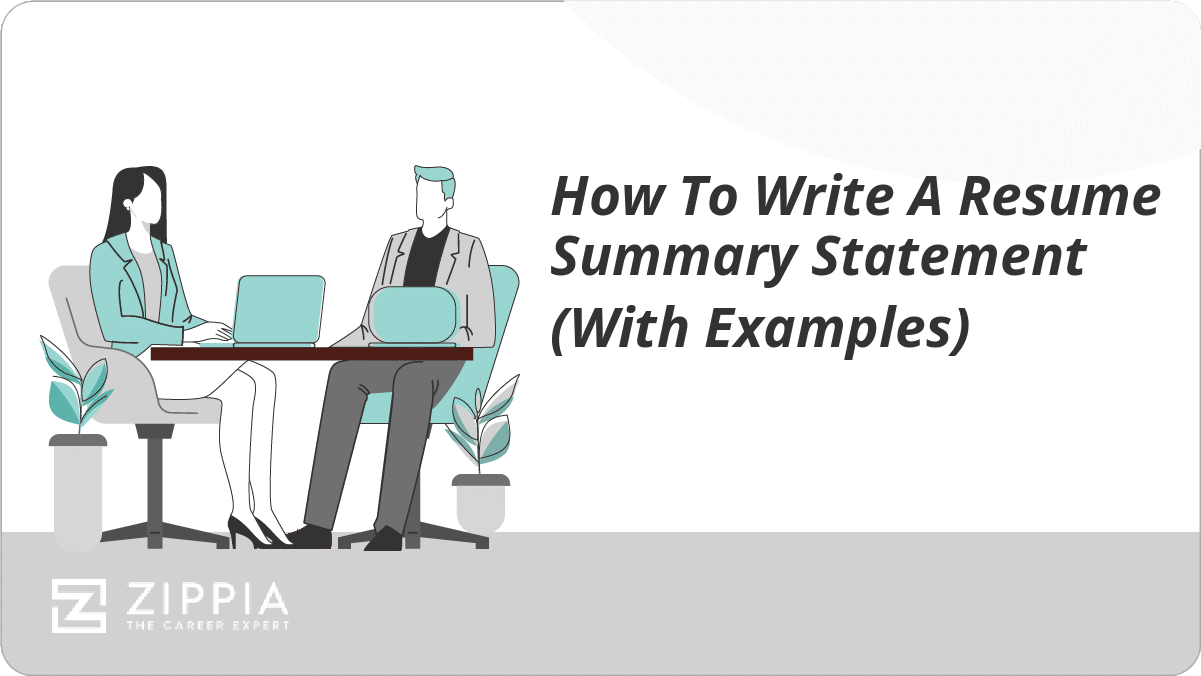- Parts Of A Resume
- How To Write A Resume
- Resume Skills Section
- Resume Objective Section
- Career Objective Section
- Resume Reference Section
- Resume Summary Section
- Resume Summary Example
- Resume Interests Section
- Address On Resume
- Relevant Work Experience
- Anticipated Graduation Date On Resume
- Education Section On Resume
- Contact Information On Resume
- Statement Of Qualifications
- How To List Publications On Resume
- Accomplishments On Resumes
- Awards On Resume
- Dean's List On Resume
- Study Abroad On Resume
- Resume Format
- Resume Templates
- General Resume Examples
- Resume Builder
- Resume Format
- Resume Margins
- Resume Header
- Work Experience On Resume
- Irrelevant Work Experience
- Listing Languages On Resume
- Volunteer Work On Resume
- GPA On Resume
- Resume Title
- Summary Of Qualifications
- Resume Picture
- Python Project On Resume
- Google Docs Resume Template
- Professional Bio On Resume
- Multiple Positions At Same Company
- Relevant Coursework Resume
- Where And How To Put Internships On Your Resume
- Professional Resume Formats
- Resume Types
When you’re trying to help your resume stand out from the crowd, a resume summary statement can be a gamechanger. This brief overview of who you are as a professional sets the stage for the rest of your resume and gives the hiring manager a fuller picture of what you bring to the table.
In this article, you’ll learn how to write the perfect resume summary statement, read some examples of summary statements, and gain a better understanding of the value of a resume summary statement.
Key Takeaways
-
Tailor your resume summary statement to each position you apply for.
-
Your resume summary statement should focus on who you are as a professional — don’t try to fit in your entire resume.
-
Keep your resume summary statement to two to four lines long.
-
A resume summary statement is not the same thing as an objective statement.

How to Write a Resume Summary Statement
Like your cover letter and resume itself, you’ve got to tailor your summary statement to each position. If you’re submitting it to a job search website and can’t really customize it, then decide upon a target industry and do the best you can for that field.
Follow our five-step method for how to write a resume summary statement:
-
Decide upon a title. This is the headline that sums you up. It’s pretty much the only part of your summary that is just about you. You should begin with a title that explains your professional identity, such as:
Capitalize each word. It’s a bonus if your title genuinely matches the position. Be precise and be honest – if you just graduated with a degree in business, you’re not a business analyst yet.
-
Research the company and position. It should go without saying, but you need to know as much about this position as possible.
-
Read the job posting again. What words do they use to describe the company, the position, and the right applicant? Try to include any prominent keywords and qualities.
-
Read the company’s website. Match any characteristics that repeat across their pages. If you found the job posted on a third-party site, is the job listing any different on their careers section?
-
Read other companies’ listings for similar positions to borrow some of their language.
-
-
Keep the summary brief. The average hiring manager will spend a matter of seconds glancing at a resume before they decide how to act.
You want to make sure that it’s not a large block of text they’ll be tempted to skip over for an easier-to-digest snippet. We’re talking:
-
Four to six points
-
Two to four sentences
-
Bullet points are fine
There’s no need to write filler if it feels short. It’s about the economy of words – each one has to earn its place.
-
-
Tell them what you offer them. The job market is a seller’s market these days, so you need to make a quick, convincing case for why they should choose you.
Do not turn it into an objective statement by ending with something like “I hope to secure a ______ position with your company”.
-
List certifications, skills, and experience you can bring. For the love of all things holy, don’t say Microsoft Office.
-
Include duties you’re particularly good at that are relevant to this position.
-
Be able to back your claims up with examples in your resume.
Don’t steal your job descriptions’ thunder or be redundant, but think about anything you may have left over that didn’t make its way into the rest of your resume.
-
Have you streamlined a process and saved money? How much?
-
Do you have any achievements of note that you intend to repeat in this new position? Which?
-
Did you take any projects from inception to fruition? Did they add any value?
-
-
Some things to avoid. As with all things resume, don’t lie. Also:
-
Don’t list things that you’re good at but hate doing unless you want a job that you hate doing.
-
It’s called a resume summary statement, but it’s a statement summarizing you – not your resume. Keep it short.
-
Don’t mention your proficiency with Microsoft Office – I hope I’m making that clear – unless you’re a wizard with Excel.
-
Avoid hackneyed words like “results-oriented”, “data-driven”, and “team-player;” they’re a waste of space. It’s the cereal in Lucky Charms. We want the marshmallows.
-
Resume Summary Statement Examples
-
Example Answer 1: Marketing Writer
A creative and experienced writer combines a background in technical writing and journalism with expertise in medical writing to deliver quality, customized content in diverse content media – public relations, content marketing, web content, and software manuals. Reliably meets deadlines and thrives in an agile, quick turnaround environment while providing sales support and client-oriented projects.
-
Example Answer 2: Administrative Office Coordinator
Adaptable, reliable and expedient with more than three years of experience supporting managers and leadership in fast-paced workplaces. Versatile skills include human resources, recruiting, customer relations, project management, and administrative support. Expertise with managing online communications platforms and multiple phone lines.
-
Example Answer 3: Mergers and Acquisitions Executive
A tested leader of international holding companies offers 10 years of expertise in developing proven growth strategies, mentoring both individual representative and team leaders in product benefits and client service techniques. Also known for creating engaging marketing campaigns that capture markets in a variety of verticals. Effectively improves profits and losses reports through innovative Mamp;A operations.
-
Example Answer 4: Recent College Graduate
Dedicated Statistics major with proven mathematical and actuarial abilities. Graduated with a 4.0 GPA and award for Exceptional Research Project. Diligent Junior Actuary for XYZ Consultancy – increased efficiency of risk reports by 9% in first three months.
-
Example Answer 5: Sales Representative
Driven sales manager with over 6 years of experience driving profitability through team leadership, strategic growth, and process improvement. Increased customer satisfaction team-wide by an average of 4% annually while increasing sales by 22%.
-
Example Answer 6: Project Manager
Project manager with 10+ years of experience managing software projects, coordinating teams of 100+ subcontractors, and allocating and analyzing budgets. Managed a project budget of $20M while reducing costs by an average of 13% year-over-year.
-
Example Answer 7: Business Anaylst
Highly-trained business analyst with more than 4 years of experience in business management, computer services, and order processing. Monitored accuracy of business process ordering, increasing efficiency by 12% from implementation to execution.
-
Example Answer 8: Customer Service Position
Cusomter service professional with a commitment to customer satisfaction while upholding corporate goals and branding.
-
Example Answer 9: Teacher
Spirited elementary school teacher with over ten years of childcare, tutoring, and teaching experience. Organized new curriculum and standardized test preparation, increasing reading scores by 8% in one year.
-
Example Answer 10: Retail Manager
Energetic retail associate with 6+ years of experience driving customer traffic and engagement through product knowledge and a friendly demeanor. Efficient in training customer service teams to provide the best experience for shoppers and staff.
-
Example Answer 11: College Student – English
English Literature student with leadership and academic training at the University of Rhode Island. Expertise in social media platforms and Microsoft Office. Proven experience in research projects, time management, and organizational skills with a background in office administration. Able to provide employers with administrative support and professional communication skills. -
Example Answer 12: College Student – Biology
Biology major with demonstrated skills in research activities and clinical experiments. Blends academic training with lab management experience from Boston College. Incorporates administrative experience in an office setting to provide employers with proven scheduling, communications, and organizational expertise.
The Five W’s of a Resume Summary Statement
-
What is a resume summary statement? A resume statement summary is more or less just a few well-worded, targeted sentences that sum up your skills and experiences. Think of it as a shortened cover letter or a written elevator pitch.
-
Where does a resume summary statement go? At the top of your resume, just under your contact information. The purpose is to quickly grab the hiring manager’s notice as soon as they begin reading – which is, you know, usually at the beginning.
-
Why do I need a resume summary statement? To make sure the reader gets the gist of who you are as soon as possible. Imagine you’re a hiring manager skimming dozens of resumes – kind of like a jobseeker skimming dozens of resume templates.
Some employers run resumes through screening software, so this is an opportunity to stick some keywords in that don’t mesh with your job description bullet points.
-
Who needs a resume summary statement? If you can write a good one (more on that below) pretty much everyone benefits:
-
If you’ve got a lot of experience in your field, it summarizes your achievements.
-
If you’re making a change in industries, it ties together your experiences.
-
If you’re just starting out, it explains how your academic experience is relevant.
But if you want to indicate that your resume is either outdated or a template from Microsoft Word, use an objective statement.
-
-
When don’t I need a resume summary statement? Remember how I said you should write a good one? If you don’t have much to summarize because of limited work experience or academic experience that’s not relevant to this role, omit it altogether.
Save the precious page-one space – expand your job role sections instead.
-
How long should a resume summary statement be?
A resume summary statement should be about two to four lines long. Your summary should be short and to-the-point because it’s designed to grab readers’ attention, not bog them down with a list of every job you’ve had or your reasons for choosing your career.
-
Should I write a resume summary?
Yes, you should write a resume summary. Unless you have very little experience and can’t write a good resume summary, it’s generally a good idea to include one on your resume.
A solid resume summary sets your resume apart from the rest and gives hiring managers a sense of what you bring to the table right off the bat.
-
What’s an executive resume summary?
An executive resume summary is another name for a resume summary. Hiring managers may request an executive summary if you’re applying for a high-level or executive position.
They do this because having a summary of your experience makes it easier for them to sift through your extensive work history to find the most important pieces.
The Benefits of a Resume Summary Statement
This is your foot in the door. Think about it in terms of Tinder.
Say you’re a hiring manager out on the prowl, and it’s hard to find the right one. You’ve got a pretty long list of criteria and some high standards – your work friends say they’re too high and you should just settle.
So, then on Taco Tuesday you have five tacos and like seventeen strawberry margaritas. Whatever, they were on special. Inhibitions are lowered, and you give the online thing a shot.
Now, you’ve got a lot to offer people, and all sorts of folks want your attention. You’re slammed with potential – lucky you – and as important as matching with the right one is, you just don’t have time to really look at each one.
There’s a whole lot of swiping left going on.
Face tattoo. Swipe left.
Grammatical errors. Swipe left.
Then, suddenly, you see someone with a cute, genuine smile. Intrigued, you look closer. A hiking selfie picture holding a puppy dog and a child – the caption says, “the dog is mine, the kid is my sister’s lol.” Swipe right.
The smile is a decent-looking resume format. The outdoorsy selfie is a college degree. The cute dog picture is your resume summary statement.
The tattoo and errors are tattoos and errors. Sorry, not sorry.
If you want to stand out (for the right reasons), a winning summary statement can help recruiters see how qualified you are at a glance.
A Note for Recent College Graduates
There’s a school of thought that says that young people don’t need summary statements – if I agreed, I wouldn’t have bothered with the Tinder analogy.
It’s okay to rely on academics to strengthen your qualifications, just make sure that you describe what you actually did. If you acquired some skills that are relevant to the workplace, make them work for you here.
If you find yourself trying to BS your way through it, then just leave it out entirely.
Resume Summary Statement vs. Resume Objective
A resume objective is a statement about your career goals, while a resume summary statement showcases the most impressive professional experiences and skills you have.
Some say a resume objective works best for those with limited experience, like recent college graduates or someone making a career change.
We wholeheartedly disagree.
A resume objective might look something like this:
Copywriter seeking an opportunity to draw upon my skills in editing, graphic design, and content strategy to help increase company website traffic and drive B2B and B2C content engagement.
That’s a very good resume objective, but it’s still a whole lot less impressive than a resume summary statement. That’s because resume objectives are all about what you want as an applicant, not about what you offer the company.
A great resume and cover letter will highlight precisely what you, the job-seeker, can offer the employer.
A basic resume objective only tells the recruiter that you want a job; they already know that. Let’s transform that resume objective into a summary statement.
Accomplished copywriter with over five years of experience in digital marketing, content strategy, and graphic design. Have increased organic search traffic by 43% year-over-year for the past three years through engaging B2B and B2C content.
It’s not crazy different, but it sounds a whole lot more impressive. The hiring manager or recruiter now knows exactly what you’ve done in your career and is more likely to call you in for an interview.
Resume Summary Statement FAQ
Final Thoughts
A resume summary statement is a very short section at the top of your resume that can make a big impact on recruiters and hiring managers.
Whether you’re a job seeker with plenty of impressive and relevant experience or a recent graduate with hardly any, a resume summary statement puts your accomplishments front and center.
Taken together with a stellar cover letter, your resume summary statement allows employers to understand your professional experience more thoroughly.
Remember to make small adjustments to your resume summary statement depending on the employer and the job description.
With a tailored resume summary statement, you’re sure to get called for interviews more often.
Ask the Experts
What’s a quick resume tip?
Tonia Derkos
Professional Resume Writing
My tip is to get rid of objectives — employers don’t care about your objective, they only care that you can fulfill their objective.
Instead, have a profile highlighting key strengths, skills, and accomplishments with concrete examples, such as percentages, goals achieved, and a proven track record of success.
- Parts Of A Resume
- How To Write A Resume
- Resume Skills Section
- Resume Objective Section
- Career Objective Section
- Resume Reference Section
- Resume Summary Section
- Resume Summary Example
- Resume Interests Section
- Address On Resume
- Relevant Work Experience
- Anticipated Graduation Date On Resume
- Education Section On Resume
- Contact Information On Resume
- Statement Of Qualifications
- How To List Publications On Resume
- Accomplishments On Resumes
- Awards On Resume
- Dean's List On Resume
- Study Abroad On Resume
- Resume Format
- Resume Templates
- General Resume Examples
- Resume Builder
- Resume Format
- Resume Margins
- Resume Header
- Work Experience On Resume
- Irrelevant Work Experience
- Listing Languages On Resume
- Volunteer Work On Resume
- GPA On Resume
- Resume Title
- Summary Of Qualifications
- Resume Picture
- Python Project On Resume
- Google Docs Resume Template
- Professional Bio On Resume
- Multiple Positions At Same Company
- Relevant Coursework Resume
- Where And How To Put Internships On Your Resume
- Professional Resume Formats
- Resume Types





